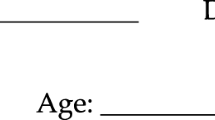Abstract
Burgess' Attitude and Belief Scale, a measure of Ellis' irrational beliefs, was administered to a large sample of outpatients. All 13 subscales demonstrate very adequate internal consistency. A factor analysis yielded one factor accounting for 83% of the variance, which was labeled “irrationality”. Clients endorsed “focused” items more than “overgeneralized” items, “self-referential items more than “non-self-referential” items, and “preferential” items more than “irrational” items. Clients also received higher scores on the irrational process of demandingness than they did on the irrational process of awfulizing, self-worth and low frustration tolerance. The results were consistent with new formulations in Rational-Emotive theory. Suggestions were made for the construction of measures of irrational beliefs.
Similar content being viewed by others
References
Beck, A. T. (1976).Cognitive therapy and the emotional disorders. New York: International Universities Press.
Bernard, M., and DiGiuseppe, R. (1989). The development of Rational-Emotive Therapy. In M.E. Bernard and R. DiGiuseppe, (Ed.).Inside RET: A critical appraisal of the theory and therapy of Albert Ellis. Orlando, Florida: Academic Press.
Besai, J., and Lane, S. (1976). Self-rating scale for rationality.Rational Living, 11, 28–30.
Burgess, P. (1986). Belief systems and emotional disturbance: An evaluation of the rational emotive model. Unpublished doctoral dissertation: University of Melbourne, Parkville, Victoria, Australia.
Burgess, P. (in press). Towards resolution of conceptual issues in the assessment of belief systems in rational-emotive therapy: Some preliminary results.Journal of Cognitive Psychotherapy: An International Quarterly.
Campbell, I. (1985). The psychology of homosexuality. In A. Ellis and M. E. Bernard (Eds.),Clinical Applications of Rational-Emotive Therapy. New York: Plenum.
Campbell, I. M., Lowe, B., and Burgess, P. M. (1983).RET anatomy of neurosis. Unpublished manuscript. University of Melbourne, Parkville, Victoria Australia.
Crocker, L. and Algina, J. (1986).Introduction to classical and modern test theory. New York: Holt, Rinehart, Winston.
Cronbach, L. S. (1951). Coefficient alpha and the internal structure of tests.Psychometrika, 16, 297–334.
Demaria, T. P. (1986). Predicting guilt from religiosity and irrational beliefs. Unpublished doctoral dissertation, Hofstra University.
Demaria, T. P., Kassinove, H., and Dill, C. A. (1989). Psychometric properties of the survey of personal beliefs: A rational-emotive measure of irrational thinking.Journal of Personality Assessment.
Ellis, A. (1962).Reason and emotion in psychotherapy, Secaucus, New Jersey: Lyle Stuart. Ellis, A. (1979).
Ellis, A. (1984). The essence of RET.Journal of Rational-Emotive Therapy, 2, 19–25.
Ellis, A. (1985).Overcoming resistance: Rational-Emotive Therapy with difficult clients. New York: Springer.
Ellis, A. (1987). A sadly neglected cognitive element in depression.Cognitive Therapy and Research, 11, 121–146.
Ellis, A. (1989). Comments on chapters. In M. E. Bernard, & R. DiGiuseppe (Eds.),Inside RET: A critical appraisal of the theory and therapy of Albert Ellis. New York: Academic Press.
Ellis, A. and Bernard, M. E. (1983).Rational-emotive approaches to problems of childhood. New York: Plenum.
Ellis, A., and Bernard, M. E. (1985)Applications of rational emotive therapy. New York: Plenum.
Ellis, A., and Dryden, W. (1987).The practice of rational-emotive therapy. New York: Springer.
Hartman, B.J. (1968). Sixty revealing questions for 20 minutes.Rational Living, 3, 7–8.
Jones, R. A. (1968). A factored measure of Ellis' irrational belief system with personality and maladjustment correlates. Unpublished doctoral dissertation, Texas Technical College.
Kassinove, H. (1986). Self reported affect and core irrational thinking: A preliminary analysis.Journal of Rational-Emotive Therapy, 4, (2), 119–130.
Kassinove, H., Crisci, R., and Tiegerman, S. (1977). Developmental trends in rational thinking: Implications for rational emotive school mental health programs.Journal of Community Psychology, 5, 266–274.
Malouff, J. M., and Schutte, N. S. (1986). Development and validation of a measure of irrational belief.Journal of Consulting and Clinical Psychology, 54(6), 860–862.
Malouff, J. M., Valdenegro, J., and Schutte, N. S. (1987). Further validation of a measure of irrational beliefs.Journal of Rational-Emotive Therapy, 5(3), 189–193.
Marzillier, J. (1987). A sadly neglected cognitive element in depression: A reply to Ellis,Cognitive Therapy and Research, 11(1), 147–157.
Millon, T. (1983).Millon Clinical Multiaxial Inventory. Third Edition. Minneapolis, Minnesota: National Computer Systems.
Muran, J. C., Ross, S., and Muran, L. (1987). Irrational thinking and negative emotionality in normal and clinical adults. Unpublished manuscript. Hofstra University.
Nunally, J. (1978). Psychometric theory (2nd Ed.). New York: McGraw-Hill.
Shorkey, C. T., and Whiteman, V. L. (1977). Development of the rational behavior inventory: Initial reliability and validity.Educational and Psychological Measurement, 38, 1143–1149.
Smith, T. (1989). Assessment in rational-emotive therapy: Empirical access to the ABCD model. In M. E. Bernard and R. DiGiuseppe (Eds.),Inside RET: A critical appraisal of the therapy and theory of Albert Ellis. New York: Academic Press.
Smith, T. (1982). Irrational beliefs in the cause and treatment of emotional distress: A critical reivew of the rational emotive model.Clinical Psychology Review, 2, 505–522.
Tosi, D. J., Forman, M.A., Rudy, D. R., and Murphy, M. (1986). Factor analysis of the common beliefs survey III: A replication study.,Journal of Consulting and Clinical Psychology, 54(3), 404–405.
Walen, S. R., DiGiuseppe, R., and Wessier, R. (1980).A practitioner's guide to rational-emotive therapy. New York: Oxford University Press.
Author information
Authors and Affiliations
Rights and permissions
About this article
Cite this article
DiGiuseppe, R., Leaf, R.C. The endorsement of irrational beliefs in a general clinical population. J Rational-Emot Cognitive-Behav Ther 8, 235–247 (1990). https://doi.org/10.1007/BF01065807
Issue Date:
DOI: https://doi.org/10.1007/BF01065807



